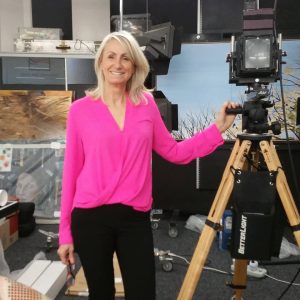
Theresa Sarjeant in her Balmain studio
Over the past 15 years, Theresa Sarjeant has been photographing and printing artwork for a broad mix of Sydney artists at all career stages. Her studio was set up to mimic that of Gary Kerr, founder of Visual Arts Imaging in the United States.
“I trained directly with Gary and use the same processes he does,” explains Theresa, who runs Fine Art Imaging from the harbourside suburb of Balmain. “Gary’s company is considered to be a global leader in visual arts services and has been entrusted to capture images of some of the world’s most famous artworks.”
Theresa’s long-held interest in photography was the starting point for establishing her own business: “My ex-husband’s father was a professional photographer, and I learned a lot from him. I love the technical aspects of the work and have taken many photography courses over the years.
“I also have good Photoshop skills, which were developed when the software was in its infancy and I was looking for a creative outlet while raising young children.”
Full disclosure – Theresa digitises and prints artwork for my sister, Melanie Vugich. In addition, when Melanie is commissioned to design fabric for New York fashion label Oscar de la Renta, the approved designs go straight to Theresa for digitising before being forwarded to the company’s fabric research and development team. We value her impeccable work and professionalism.
Here Theresa discusses the processes she uses to ensure high-quality results, the value of having artwork digitised and her advice for artists who haven’t yet started having their work professionally captured.
Interview by Lisa Doust.
What does the digitising process involve?
My clients deliver their framed or unframed paintings, or works on paper, and the process starts with setting the artwork up for photography on the purpose-built wall in my studio.
I use an ultra-high-resolution art capture system that delivers images with 200 to 300ppi (pixels per inch) resolution at full scale. This ensures faithful colour, sharpness and the ability to scale art up or down when going to print.
My high-quality LED lighting illuminates the work evenly, and a series of optical-grade mirrors and lasers align the artwork surface to the camera. I also employ state-of-the-art colour management software to ensure the colours are true to life.
Once an artist has their work digitised, what can they do with the image?
Artists use their images for a variety of reasons but most commonly for printing to scale. The digital file is approximately 400 to 500MB (megabytes), which enables the artist to print up to about 150 x 150cm.
The file can then be reduced in size for other uses, such as for print in publications and brochures, or for printing onto fabric and products.
What is the largest size artwork you have the capacity to photograph and print?
The largest size painting I can handle is approximately 2 x 3 metres.
What is the smallest size painting you recommend having digitised, and what size can it be scaled up to as a print?
I was once given a photograph which was about 20 x 20cm and reproduced it to 140 x 140cm. I don’t always advise this, and it’s very much dependent on the work itself.
Which printing process do you use?
The Giclée printing process, which has an archival rating of greater than 100 years. I print on both archival-quality paper and canvas, and the archival-grade pigments result in fade-free images that are as close to the original artwork as possible.
What are your tips for artists wanting to have their work digitised?
When budgets are limited, I would advise artists start by getting their best artworks digitised, one at a time. This will give them options in the future if they want to go down the path of offering prints or licensing their work, both of which provide extra revenue streams. Having your work digitised is also helpful for portfolio and archiving purposes.
Keep in mind that once an artwork is sold, you won’t have the option to have it digitised and will lose the ability to extend your earning capacity from the work.
Follow Theresa via @fineartimaging.sydney or visit fineartimaging.com.au
